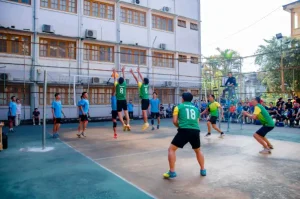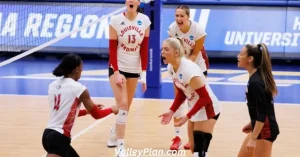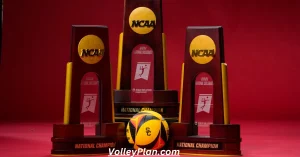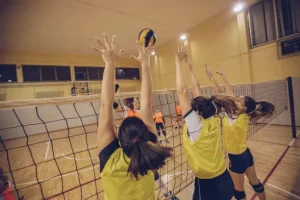Pepper volleyball is a practice drill that enhances players’ skills and teamwork. It involves two players who repeatedly hit the ball back and forth, focusing on precision, control, and communication.
This drill is crucial for warming up before a game and improving players’ overall performance on the court. This drill is an exhilarating sport that has gained popularity for its fast-paced and dynamic nature.
In this blog, we will explore the key aspects of pepper, shedding light on its rules, techniques, benefits, pepper variation, tips to improve, and the sheer excitement it brings to players and spectators alike.
Rules of Pepper Volleyball
To engage in an effective pepper drill session, players follow specific rules. The drill emphasizes controlled hits, proper footwork, and quick reactions.
Unlike a regular game, there’s no net in pepper drill, allowing players to concentrate solely on their skills without the distractions of a competitive match.
Pepper drill is a warm-up drill played with two players, but it can also involve three or more participants. The primary objective of the game is to practice and enhance essential volleyball skills, including passing, setting, and hitting. The rules are typically straightforward:
| Sr No | Rule | Description |
|---|---|---|
| 1 | Player Setup | Two players face each other with a distance of 5–20 feet (2–6 meters) apart, though the exact distance may vary based on player preference. |
| 2 | Ball Movement | The drill involves a sequence of passing, setting, and hitting. The players work together to keep the rally going, focusing on controlled touches. |
| 3 | Objective | The primary goal is skill improvement rather than competitive scoring. Players aim to maintain a consistent and controlled exchange of the ball to refine their fundamental techniques. |
| 4 | Variations | There are variations of pepper, including changing court quarters after each set or introducing movement and conversation skills to make the drill more dynamic. |
| 5 | Warm-Up | Pepper is commonly used as a warm-up before practices and matches to prepare players physically and mentally for more intense gameplay. |

Techniques for Success
Mastering pepper drill requires honing various techniques. Players focus on accurate passing, setting, and spiking, ensuring a seamless exchange of the ball.
The emphasis on technique not only improves individual skills but also enhances the coordination between teammates.
Benefits Of Pepper Drill
Pepper drill offers numerous benefits for players of all skill levels. It improves reflexes, strengthens core muscles, and fosters effective communication among team members.
Additionally, the drill’s fast-paced nature contributes to cardiovascular fitness, making it an ideal warm-up activity.
Transitioning to Game Play
While pepper drill serves as a valuable practice drill, its ultimate purpose is to prepare players for actual game scenarios. The skills developed during pepper drill sessions seamlessly transition into competitive matches, contributing to a team’s overall success.
Pepper Variations
This is a common volleyball drill, has several variations that teams use for warm-ups and training. These variations add diversity and challenges to the standard pepper drill. Here are some notable pepper variations:
| Sr No | Variation | Description |
|---|---|---|
| 1 | Overhand Pepper | Involves players using overhand passes instead of the traditional forearm passes, focusing on ball control. |
| 2 | Rotating Pepper | Players rotate positions while maintaining the pepper drill, enhancing adaptability and communication on the court. |
| 3 | Quick Pepper | Emphasizes quick and precise passes, promoting rapid ball movement between players. |
| 4 | 3-Person Variation | Involves three players positioned differently, adding complexity to the drill and enhancing coordination. |
| 5 | 6-Person Pepper | A larger-scale variation where six players participate, providing a team dynamic to the drill with added challenges. |

Tips To Improve “Pepper” Drill
“Peppering” in volleyball is a crucial drill for improving ball control, communication, and overall skills. Here are some tips to enhance your peppering technique:
Start at a Close Distance
Begin about 5 to 8 feet apart from your partner and gradually increase the distance as your skills improve. This allows you to focus on controlled passes and sets.
Gradual Increase in Pace
Initiate the drill at a slow and controlled pace, emphasizing precision over speed. As you become more comfortable, gradually increase the pace to challenge your reflexes and coordination.
Topspin Technique
When hitting, focus on wrapping your hand over the top of the ball to create topspin. This imparts more control and accuracy to your hits.
Proper Forearm Passing
Ensure your feet are positioned behind the ball when forearm passing. This helps in maintaining balance and generating accurate passes.
Avoid Reinforcing Improper Techniques
While peppering is valuable, avoid relying solely on it. Incorporate other drills and warm-ups that mimic game situations to reinforce proper techniques.
Variations For Challenge
Experiment with variations such as rotating pepper or two-ball pepper to add complexity and challenge to the drill.
Peppering is not just a warm-up but a fundamental drill for improving your overall game. Focus on precision, gradually intensify the drill, and incorporate variations to keep your practice dynamic and effective.

Why Do Volleyball Players “Pepper”?
All players engage in the drill known as “pepper” for various reasons:
- Warm-Up: Pepper serves as an effective warm-up exercise before practices and matches. It helps players loosen up, enhance their range of motion, and prepare physically for the game.
- Ball Control: The drill is designed to improve ball control skills, including passing, setting, and hitting. Players focus on precise and controlled touches, contributing to overall skill development.
- Communication: Pepper encourages communication between players on the court. Effective communication is vital in volleyball, and the drill provides a setting for players to practice verbal and non-verbal cues.
- Game-Like Situations: While peppering may seem repetitive, it helps simulate real-game scenarios. Players can practice various techniques in a controlled environment, translating these skills to actual gameplay.
- Movement and Conversation Skills: Advanced variations of pepper involve movement and conversation skills, introducing dynamic elements to the drill. This helps players adapt to different situations during a match.
In summary, pepper is a versatile drill that not only prepares players physically but also focuses on fundamental skills, teamwork, and game-like situations, contributing to an improved overall performance on the court.
FAQs
The volleyball word “pepper” comes from a baseball drill where players quickly caught and threw the ball back and forth. In volleyball, it turned into a warm-up game where players quickly hit and bump each other, with the goal of improving their skills.
A pepper in sports, particularly in volleyball, refers to a warm-up drill where players pass, set, and hit the ball back and forth to improve fundamental skills and prepare for more intense gameplay.
Two people practice pepper drill facing each other, throwing, setting, and hitting the ball in a controlled order to improve basic skills. The training is more about improving skills than about competing.
To get better at volleyball precision, work on your hand-eye coordination with specific drills. Focus on using the right hand position and making good touch with the ball as you practice passing and setting the ball. Additionally, work on improving the coordination of all of your muscles so that your shots are more exact.
The power position in volleyball is the best way for a player to stand before they attack. It involves standing with your feet shoulder-width apart, your knees bent, your weight forward, and your arms ready. This stance lets players hit with the most power and accuracy.
Conclusion
In conclusion, this drill stands out as a dynamic and effective practice drill in the world of volleyball. The emphasis on skill development, teamwork, and rapid reflexes makes it crucial to any player’s training. As you enjoy pepper drill, remember that it improves your skills and adds fun.
Related Posts
Volleyball Serve Receive Drills
10 Best Middle School Volleyball Drills

Hassan Baig a former volleyball player, coach and Administrative At Volleyplan.com.
My name is Hassan Baig and I am a former volleyball player and coach. I have a passion for the sport and have dedicated my life to promoting it. I have worked with some of the best players in the game and have helped them achieve their full potential Read More









